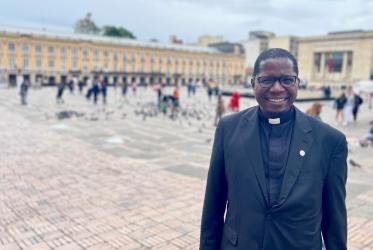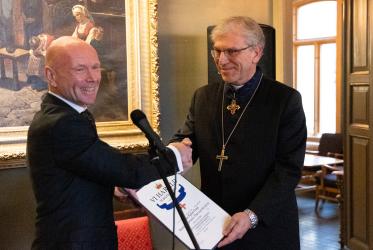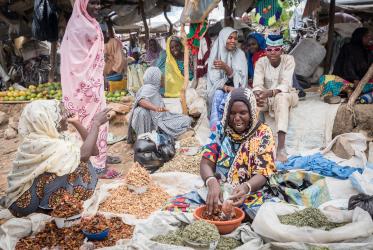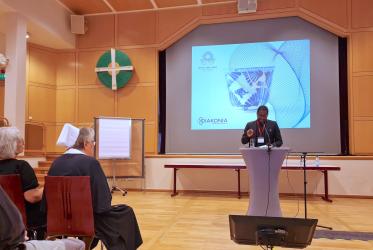Sermon for the service of installation of Rev. Dr Olav Fykse Tveit
as general secretary of the World Council of Churches
Ecumenical Centre, Geneva, Switzerland
23 February 2010
I did not come proclaiming the mystery of God to you in lofty words or wisdom. For I decided to know nothing among you except Jesus Christ, and him crucified.
(1 Cor 2:1-2)
The cross is and will forever be the sign of the church. This is the symbol that we have together, the symbol of what we have together, the symbol of what the churches have to give to the world. From the beginning to the end.
Nothing except Jesus Christ, and him crucified. Nothing except the cross. Nothing except ...
It doesn’t sound like very diplomatic language. It doesn't sound like an invitation to a dialogue. It does not even sound very ecumenical, open to the many perspectives on and of our faith to be considered in the open space. Nor does it sound very open to the many burning issues of the world today.
Nevertheless, there is a deep meaning in these words, offering substance and direction to the ecumenical movement. That’s why I’ve chosen these words from the Bible to mark the start of my service as general secretary of the World Council of Churches, at the beginning of the second decade of the 21st century.
Why these strong words of St Paul? The context he is referring to is not irrelevant to us. He is addressing divisions in the church of Corinth; divisions due to different opinions and different personal loyalties, due to the lack of willingness to share, due to ignorance of the gifts of others and their contribution, due to impatient critique of the Christian message and its ambassadors. So the answer is clear: To be one the Church must go back to its common basis. Nothing except Jesus Christ, and him crucified. “The World Council of Churches is a fellowship of churches which confess the Lord Jesus Christ as Saviour according to the scriptures and therefore seek to fulfill together their common calling to the glory of the one God, Father, Son and Holy Spirit.”
This does not mean that there are no other themes to be discussed, or any other concern to be considered, or any other people to be mentioned. Quite the contrary. St Paul has a lot to say in the same letter about sharing everything in solidarity, recognizing one another as part of one body. In this letter we find the great hymn to and praise of love: “If I have prophetic powers, and understand all mysteries and all knowledge, and if I have all faith, so as to remove mountains, but not love, I am nothing.” (1 Cor. 13:2). Paul goes on to say that there is no meaning in the Christian faith, particularly not in the death of Jesus Christ on the cross, if Christ has not been risen from death (chapter 15). Right preaching and correct theology about Jesus Christ have no effect without the power of the Holy Spirit. Still, his message remains: nothing except Jesus Christ, and him crucified.
The cross is the perspective that must not be missed out. The cross is the reality check of all our talk about God – and about life. With the perspective of the cross our talk about God can not just be lofty words. For God has through the cross bound himself to reality, to all aspects of reality: to both death and life, and even to the unjust, inhuman and incomprehensible suffering and death in this world. By becoming a human being, by facing and feeling everything that human life involves and implies, we can believe that God is with us. In the perspective of the cross we hear the songs and prayers of the people of Haiti; in the perspective of the cross we can believe that God can be with human beings in all things. Even in death. And therefore the tree of the cross can be a sign of life.
St Paul not only sees the cross as the sign of how God is with us, but also how God is for us. Seen in the perspective of resurrection, the cross is not the ultimate victory of evil over good or good intentions. The cross becomes the sign of God's victory over sin and evil, a victory won through death. It is in this perspective that St Paul can also speak of Jesus Christ as a sacrifice, of God who makes the sacrifice so as to break the link between sin and death forever. Sin can be forgiven, by God. The crucified God shows us that sin and death shall not have the last word in this world. Not even when it looks like that. The cross is the sign of God’s unconditional love to all human beings, even when we were sinners, as St Paul also writes.
This is the revealed mystery of God given to us through Jesus Christ, and him crucified. This is why the cross is the symbol that all Christians have together. The cross is the first and ultimate sign of the gift of God’s gracious being with us and for us. We are one as Christians because we receive the same gift. That is why there is nothing except the cross.
The cross can have a place everywhere and give a meaning to everything. Here in the ecumenical centre and in this chapel we have different expressions of the cross. On the side altar to the left we have a cross made of splinters from bombshells that fell on Coventry and Dresden. It offers a sign of hope that even the death of war shall not be the last word, that God wants peace, a just peace where we can live together in one world sharing the gifts of this world together. On the main altar we have an Armenian cross, where the cross is embodied in powerful signs of life, flowers, sprouting branches, fruit-giving trees. The cross to the left of the altar is on top of the beautiful and impressive Indian brass oil lamp and symbol of life. In the hall you can see the cross embodied in a wooden sculpture of the African continent, reminding us how many people today are still as crucified, but also how many bear witness to the new life given through the cross. Behind the altar, and outside this chapel, as a sign of identity for the whole ecumenical centre, you find the plain, clear, strong and simple cross in modern style, inside in wood outside in concrete, bold signs of the ecumenical movement of the cross in the 20th century. My first visit to a member church is in two weeks time at the invitation of His All Holiness the Ecumenical Patriarch to participate in the feast of the Holy Cross. All over the world you will find the cross as the sign of the church.
The cross is more than a sign of our religious identity. It is the “reality check”, of our churches, of our ministry, of our ecumenical movement, of our faith, of your faith, of my faith. Crux probat omnia, says Luther. The deep and double meaning of this sentence is: the cross proves everything. The cross gives evidence to everything of what we might say about Jesus Christ. The cross proofs everything, the cross tests everything in our will to follow Jesus Christ.
The cross proves the power of giving. The cross proves the power of humility. The cross proves the faithfulness of God. The cross is also the test, the proof of our faithfulness to God and to the cause of good. We just heard in the beautiful words of the Sermon on the Mount what the meaning of following Christ or carrying our cross is: “Blessed are those who hunger and thirst for righteousness, for they will be filled.” “Blessed are the peacemakers, for they will be called the children of God.” In a world of honour and shame, of love and sin, this call can lead to confrontation with the powers of evil. In Christ’s way through human life there was no escape, only faithfulness to God’s calling to show the meaning of righteousness. Jesus Christ himself experienced the deep meaning of what he said: “Blessed are those who are persecuted for righteousness’ sake, for theirs is the kingdom of heaven.”
So we are called to carry our cross. There are burdens in any human life. Even in the honour and joy of receiving an important task for the church, there are many burdens. For everything that is important is also demanding. The call of the ecumenical movement does not have a meaning only if we succeed. Whether we are heard or not, our call is to carry the cross with one another. Are we willing to walk in the shoes of the poor and oppressed? Are we ready to carry the burden of distress when we are not in agreement, are we prepared for the disappointments when we are unable to solve all the problems we are addressing? Whatever happens, it remains our call to carry the cross in our search for unity, in our witness, in our service. And we shall do it together, never alone.
For some the burdens of life are heavier than for others. Seen as a cross, they can be seen as burdens to carry on behalf of others. Sometimes we do not see the meaning of the burdens and tasks we or others have to carry. But in the perspective of the cross we can see that we are not carrying them alone. Christ has also carried his cross, in solidarity with us. Therefore, we can dare to see the cross as a reality check our whole life through. No lofty words are involved, but always a sign pointing to something new, to a resurrection after the cross.
We must remind ourselves that we are never called to add to the burden of the cross which others bear. We are never called to ask anybody to carry their cross alone. We are never called to use the cross as an excuse for letting others suffer. We are never allowed to use the cross to make others experience injustice, oppression or suffering. We are reminded through our Lent campaign this year that there are many women experiencing violence because they are women; our faith is even sometimes used to legitimize such injustice or violence. This brings shame to the cross that Christ carried for us.
How shall we, then, best give shape to the ecumenical movement of the cross in our time? And how can the ecumenical movement be a movement of the cross – the tree of life? Perhaps we should emphasize what some of the early teachers of the church tell us: when Christ stretches out his arms at the cross, he is stretching out to the whole world, embracing everybody. One example is the colourful and powerful Latin-American cross in front of this pulpit, with images of daily life and a woman stretching out her arms to everybody and to God, in worship. Reminded of what the cross is, we see that the exclusiveness of the cross is precisely that it is inclusive.
The gift of the cross binds us together. Our open arms can be a sign of the ecumenical movement of the cross, showing that we need one another, that we want to share God’s gifts in this beloved world with all.
That is why there is nothing except the cross.
Glory be to the Father, and to the Son, and to the Holy Spirit, one true God, as it was in the beginning, is now, and will be, for ever and ever. Amen.



